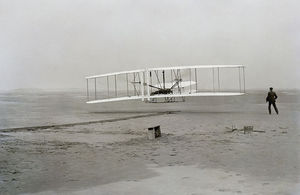It sometimes seems that each day brings some new technological innovation, some science fiction fantasy come true, and that all we need to wish for is an easier or better way and someone will develop it.
In looking back over the past ten years trying to determine the most significant scientific breakthroughs, I found the events broke down easily down into two categories: Things that changed our world and things that changed our lives.
3 Things That Changed Our World
Taking to Space
In 2003, we celebrated the 100th anniversary of the Wright Brothers historic first flight. Less than a decade later, we achieved the first commercial space flight. Man has dreamed of flying since Daedalus and Icarus, and in just over a century we have progressed from a flight on a North Carolina dune lasting just over twelve seconds and covering 120 feet to the dawn of citizen astronauts. Less than 50 years ago, when President John F. Kennedy challenged the scientific community to put a man on the moon before the end of the decade, many though the idea impossible. It was not only possible; it may soon be possible for all of us.
Is Anyone Out There?
The last decade has finally provided proof that we are not alone in the universe. We have explored planets as close as our neighbor Mars, and discovered that water existed on the red planet at some point. Not just water, but perhaps vast oceans. Using the Hubble Space Telescope, and infrared imaging, we have been able to locate new galaxies with stars and planets similar in size and distance apart to the Earth and our own sun. While we still lack the technology to travel beyond the limits of our own solar system, we must not forget that barely 100 years ago we could not yet fly. Knowing now there may be others like us out there, and that they might be trying just as hard to reach us, think of what the next 100 years might bring if we challenge ourselves.
Human Cartography
Finally, no scientific discovery ever changed out world the way the Human Genome Project accomplished in 2003. Less than 150 years ago, scientists could not prove that bacteria, invisible to the naked eye, caused illness. With the mapping of human DNA completed, scientists have a working version of the three billion letter human DNA sequence. This is nothing less than a how-to manual on the human body. Subsequent research has provided information about switches that can turn genes on and off, and the triggers for those changes. While scientific discovery will continue in other areas of human anatomy, everything from stem cell research to gene therapy changed with the Human Genome Project.
3 Things That Changed Our Lives
From The Outside In
During the Civil War, field surgeons often amputated limbs with a saw and cauterized the wound with an iron. The last decade has seen tremendous advances in minimally invasive surgery. Gone are the days when open heart surgery meant sawing through the ribcage and leaving behind a torso-long scar affectionately nicknamed a ‘zipper.’ Most common surgeries such as gall bladder and appendix removal, and hernia correction, now require an incision less than the width of a fingernail and patients can often go home the same day. Arthroscopic and laparoscopic surgeries are now more common than invasive procedures, and the technology will only continue to advance.
From Thin Air
Everyone who travels has at some point left behind a cell phone charger. The last decade has seen advances in Wireless Power Transfer capabilities which will soon render tethered charging obsolete. But the technology is not limited to cell phones and laptops. With continued advances, the technology may be able to re-charge an electric vehicle simply by parking it in the garage. Or for even greater driving range, vehicles could recharge by parking in designated spaces in a parking lot while you shopped. Perhaps if electronic vehicles become the standard, we might one day be able to embed the charging capability in our highways so we would never need to stop and recharge?
Invisibility?
A 2004 experiment dubbed ‘Gorillas in Our Midst’ asked people to watch a group of basketball players closely and count exactly how many passes they made back and forth with the basketball. Most of the test subjects never noticed the chest-thumping gorilla wandering the court. A similar study showed how the color of a bowl or plate had a significant impact on the volume of food we consumed at a meal, and how we perceived the flavor of the food. There is so much we have yet to learn about how our brain processes information, especially perceptually, but we are learning.



